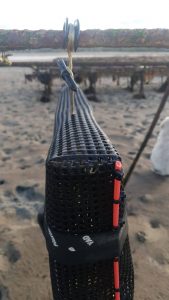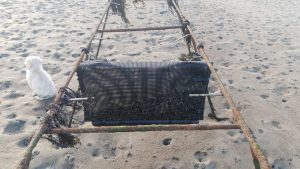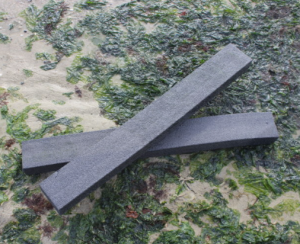We want to talk about floats, and flotation systems today.
At the recent show in Vannes everyone was talking flotation systems, it’s an idea that has really taken hold in France this year. In Ireland, the UK and further afield in Canada and Australia we’ve seen growers experimenting with their own takes on the concept as far back as 5 years ago but it looks like the French are ready to catch up.
A number of suppliers in France are in the process of trialing different approaches and we will bring those to you as they get closer to market-ready. Given the conditions that oysters are raised in, the type and length of time given to trials is so important and Triskell won’t endorse any system that we don’t believe has been comprehensively tested.
So why consider floats?
Two reasons – for you and for your oysters. A good flotation system should be working for both your benefits.
The oysters first. An oyster bag that can move with the tide gets active movement twice a day. What that means is your oysters are rolled regular ly. As a result their shape is much better than those grown in static bags attached to trestles. Regular tumbling helps to knock extra frill off the shell and means less opportunity for barnacles to attach.
ly. As a result their shape is much better than those grown in static bags attached to trestles. Regular tumbling helps to knock extra frill off the shell and means less opportunity for barnacles to attach.
Simply put, an oyster grown with a float looks great but you’re not growing those oysters just to look at! You need to be selling them and that’s why the quality is so important. An oyster that moves regularly is working all the time and that means their meat content is very much improved too. All style and no substance? Not your oysters!
What’s more that motion ensures that you get minimal algal growth choking up the mesh. That means less time spent cutting back seaweed attached to the bags or boiling empty bags and ensuring a better flow of seawater in the bags.
Better For You
So a float means better oysters and less work for you but that isn’t the end of it. Anyone who has worked in the industry for a few years knows that the work takes its toll on you physically. We’re talking about back pain, sciatica, repetitive movement strains; these come from standing for long periods lifting and shaking bags full of growing oysters. If those bags hold adult oysters then you could be talking about 10-14kg per bag. If you haven’t had a chance to split bags in time then they can get up on more than 15kg on occasion. The pressure that puts on your body is enormous.
With that in mind what is the value to you of putting floats onto your bags and cutting out all that manual labour while the oysters are growing? Pretty valuable right? So floats should definitely be something that you are considering adding to your set up.
There are currently two types of float available to attach to your bags with cable ties or a combination of ties, bands and hooks. We’ve seen some pretty inventive set ups as growers try out different ways to attach them!
Torpedo Plastic Floats
Some of you will know the torpedo floats which are made from industrial-grade plastic treated to be UV-resistant so that they are assured a long life. These floats are initially costly but the quality is undeniable. They are so tough and durable that the manufacturers are confident they will last for years of continuous use. What’s more their smooth sides make it difficult for algae to get purchase to grow on them.

We’re aware that a number of manufacturers based in Asia have been offering a similar looking product to growers recently. They’re not necessarily the same quality and you would be well advised to safe your money! The plastic is not the same grade and the quality is simply not there. A small hole or crack in one of these means that water can get in. So instead of a float you are essentially adding a weight to your bag. As the movement happens when the tide is in it may be some time before you realize what is happening and when you take them off you are left with more plastic waste. This is one situation where we’d say pay for quality and pay just once.
Foam Floats
A more economical option that many of you have been trying out over the last 12 months is the foam float. Made from high density polyethylene these floats do not absorb water so they can’t weigh down your bags. What’s more we have recently changed suppliers as we felt the new supplier would provide a higher quality product. One innovation in the new floats is that they have wax-coated the floats to prevent birds pecking at them which degrades them over time. Some of you may have experienced this yourselves when using foam swimming tubes as floats. Our foam floats are also very light and unlike the torpedoes their shape makes them easy to stack for storage.
 Of course there is a lot of work still to be done in developing a flotation system. A number of companies have contacted us with demos this year for systems that they are working on. We look forward to bringing these to you as they come onto the market. We always keep in mind that each site is unique. Each site presents a unique combination of challenges and advantages. That combination informs how you raise stock and there is always room for improvement.
Of course there is a lot of work still to be done in developing a flotation system. A number of companies have contacted us with demos this year for systems that they are working on. We look forward to bringing these to you as they come onto the market. We always keep in mind that each site is unique. Each site presents a unique combination of challenges and advantages. That combination informs how you raise stock and there is always room for improvement.
